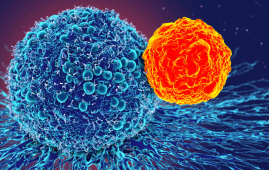

When women develop uncomfortable uterine fibroids, the standard treatment is hormone therapy, but experts note that they are focusing on other treatment options.
A research from the University of Cincinnati discovered that fibroid cells react differently to physical tension than uterine cells around them. This is significant, according to researcher Stacey Schutte, because treatment seeks to target the tumor without damaging surrounding tissue.
Fibroids are quite common: Noncancerous uterine tumors affect about 8 out of 10 women at some point in their lives. While they are usually not life-threatening, they can cause severe bleeding and agony.
According to a university news release, treating fibroids is frequently invasive, costly, and can result in infertility.
“In her lifetime, one in every nine women will have a hysterectomy.” “And one-third to one-half of those are [as a result of] uterine fibroids,” said Schutte, an assistant professor of biomedical engineering and co-author of the study published recently in the journal F&S Science.
The researchers are exploring for non-hormonal fibroid treatments, according to study co-author Andreja Moset Zupan, a research associate in Schutte’s lab.
“It’s another option we could use to preserve the fertility of women who still want to get pregnant,” she said in a university press statement.
During a woman’s menstrual cycle, her body produces estrogen and progesterone. These hormones cause the uterine lining to thicken in preparation for a prospective pregnancy, but they can also promote fibroid growth.
Schutte observed that cells can react to physical strain, which is what her team set out to research.
Fibroid and uterine cells were cultured in the lab on plates with an elastic bottom for their investigation. The cells were then pulled and stretched by a vacuum, simulating the uterine environment. They noticed changes in how cells kept their form.
“We found that fibroid cells were more sensitive to strain,” stated lead author Dr. Rachel Warwar of the University of Cincinnati’s College of Medicine. She believes the findings highlight the need of include mechanical strain, rather than only hormones, in the research of fibroid cells.
“The more we are able to mimic the environment of these cells in the uterus, the more we will understand the pathology of these cells and then can work to target anomalous pathways in fibroid cells,” Warwar went on to say.
Once the pathology is understood, researchers can utilize 3D simulations and models to learn more about how tumors arise and the best approaches to treat them. The next stage will be to create more complicated tumor models.
“It makes me really happy to think we can find a target,” she remarked.
Fibroids are a big health-care expense, according to researchers, costing up to $9 billion every year in the United States alone.
more recommended stories
 T-bet and the Genetic Control of Memory B Cell Differentiation
T-bet and the Genetic Control of Memory B Cell DifferentiationIn a major advancement in immunology,.
 Ultra-Processed Foods May Harm Brain Health in Children
Ultra-Processed Foods May Harm Brain Health in ChildrenUltra-Processed Foods Linked to Cognitive and.
 Parkinson’s Disease Care Advances with Weekly Injectable
Parkinson’s Disease Care Advances with Weekly InjectableA new weekly injectable formulation of.
 Brain’s Biological Age Emerges as Key Health Risk Indicator
Brain’s Biological Age Emerges as Key Health Risk IndicatorClinical Significance of Brain Age in.
 Children’s Health in the United States is Declining!
Children’s Health in the United States is Declining!Summary: A comprehensive analysis of U.S..
 Autoimmune Disorders: ADA2 as a Therapeutic Target
Autoimmune Disorders: ADA2 as a Therapeutic TargetAdenosine deaminase 2 (ADA2) has emerged.
 Is Prediabetes Reversible through Exercise?
Is Prediabetes Reversible through Exercise?150 Minutes of Weekly Exercise May.
 New Blood Cancer Model Unveils Drug Resistance
New Blood Cancer Model Unveils Drug ResistanceNew Lab Model Reveals Gene Mutation.
 Healthy Habits Slash Diverticulitis Risk in Half: Clinical Insights
Healthy Habits Slash Diverticulitis Risk in Half: Clinical InsightsHealthy Habits Slash Diverticulitis Risk in.
 Caffeine and SIDS: A New Prevention Theory
Caffeine and SIDS: A New Prevention TheoryFor the first time in decades,.

Leave a Comment